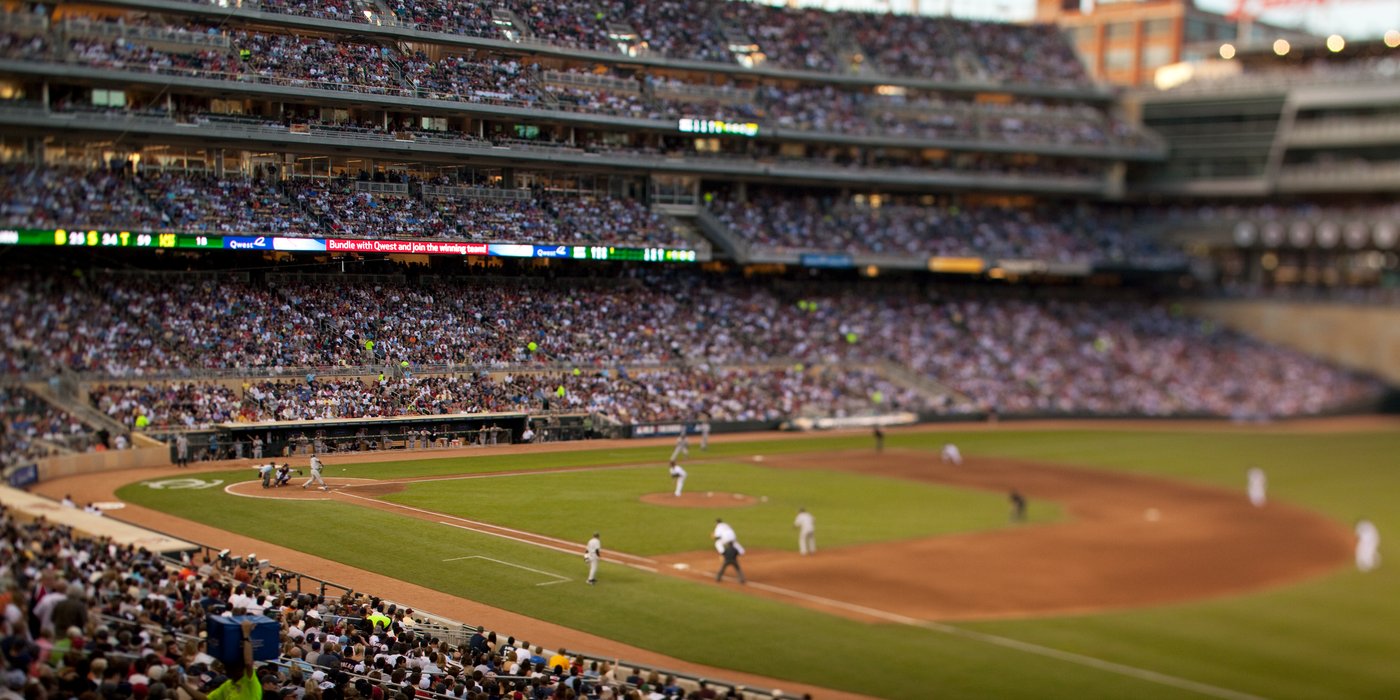Though the Twins didn't make it to the World Series this year, their home field took the spotlight earlier this year with the All-Star Game. (See our post on the economic impact of major events like this.)
We reached out to Sam Henschen, senior manager of Twins Productions at the Minnesota Twins Baseball Club to learn about the behind the scenes production of a baseball game. Hanschen is responsible for everything you see and hear at Target Field, from scoreboards and graphics, to music, PA announcements and even the flyover (see the video above).
Describe what goes into producing a game in the stadium.
Our team works every day to produce content for sponsors, our marketing department and our own ideas to create an enjoyable atmosphere surrounding the game of baseball at Target Field.
Basically, every day, I take a list of everything that needs to happen, and put the puzzle together.
For pregame, it’s taking all the requests (ceremonial pitches, check presentations, fan contests, etc.) and fitting them in so that first pitch can happen on time.
In-game, it’s executing all our sponsor commitments, taking care of any crowd shot or message requests, and making sure we’re prepared for all baseball-related elements (new players for the Twins and the visitors, statistical milestones that could be achieved, etc.).
What do you prefer about being in the scoreboard room for regular games and events like the All-Star Game instead of being in the crowd?
The best part of being “behind the scenes” is having the ability to watch a regular baseball game, and think of ways to keep the fans engaged with what is going on. If the game is not interesting or the home team is losing by a lot, finding other ways to entertain the fans with other methods.
Did you ever think you would one day be producing an MLB All Star Game?
Once Target Field was built, we all knew the All-Star Game would be a possibility. I knew our whole team could handle it and we put all our forces together to get the job done.
What are the major differences between a regular game and the All Star Game?
The biggest difference is that MLB is ultimately in charge, our team is tasked with taking all of MLB’s requests and making them come to life. While we understand our process, MLB doesn’t (and they shouldn’t). So, connecting their workflow to ours was difficult.
When did planning for the 2014 MLB All Star Game in-game productions begin?
It was announced in the summer of 2012, so very minor planning began then. MLB started having regular meetings toward the end of the 2013 regular season. We really started ramping up in the fall of 2013, and then we actually started building stuff beginning in April 2014, once the Twins regular season started up.
We were busiest in June. Building scripts, starting to build actual content, getting MLB sponsor requests. The Twins were home June 30-July 6, and while we did our Twins games as normal, much of the day was spent dealing with MLB and their requests.
July 7-12 leading up the All-Star events were 15+ hour days every day. Because during the day you are going to meetings and answering emails. Finally, once 6pm rolled around, you could actually start crossing things off your list.

What was All-Star game-day like for you?
By the time the All-Star Game arrived, whatever preparation was done, was done. There was no point in trying to do anything else. Take all the elements you’ve built and use them to the best of your ability. You don’t want the whole day to be crazy trying to invent even more things to do. Take what you have and execute that perfectly, and the day will go well.
Were the Twins able to make the 2014 All Star Game unique to Target Field’s game experience?
This was a shared endeavor. MLB hires their own content developers for the events, which is a huge help to us. MLB and the Twins teamed up on the general look of everything, and how every laid out. Prior to the event, we meet with their content team and make sure everything that needs to be built is. We want to make sure that there isn’t any doubling-up of work, so that the most unique content can be built.
How would producing the All-star game compare to producing the World Series?
Since the Twins haven’t been fortunate to be in the World Series since 1991, I will take an educated guess as to how the two events compare.
MLB, as they do with the All-Star Game, takes the reins of the World Series. I believe one difference for the host team is that, unlike the All-Star Game, the host team has a rooting interest in the home team’s performance. Therefore, the home team has the ability to enhance their squad with videos, graphics, etc. to keep their fans engaged. At the All-Star Game, there is more of a sense of neutrality, since all 30 teams are represented.
Thus, the goal of producing a World Series game is to balance all the MLB requests, while making sure the San Francisco Giants or the Kansas City Royals keep their “home advantage” for their team and fans.

What are the biggest memories you will take away from the All Star Game?
My favorite memory is the standing ovation the control room erupted in after the final element completed. Just a big sigh of relief and a moment of exhilaration that we made it through this huge event with no regrets. Everyone did their job superbly and it was a true team effort.
Ask me about another All-Star game in 5 years. After you do one, you want to take a long break from having to do another. I think Target Field 20 years from now would still be a cool place to host it. Imagine what the landscape will look like then!







